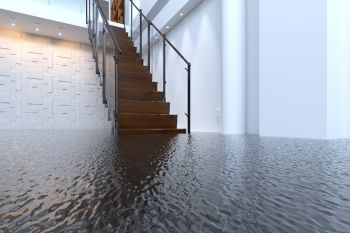 When buying a house in a flood zone, you're probably thinking, "Do I need flood insurance?" The answer is yes if you buy in a flood zone with a mortgage. That's because mortgage lenders don't want to risk losing the asset backing your home loan. And when lenders protect themselves, they also protect you.
When buying a house in a flood zone, you're probably thinking, "Do I need flood insurance?" The answer is yes if you buy in a flood zone with a mortgage. That's because mortgage lenders don't want to risk losing the asset backing your home loan. And when lenders protect themselves, they also protect you.
Is flood insurance worth the cost? Very likely -- here's why:
Cost of flood damage
According to Floodsmart.gov, even a few inches of water on your floor can do extensive damage. Here is the estimated damage to a 2,500 square foot house for flooding between one inch and four feet in 2019; given the escalation in home values and effects of inflation, these costs are surely considerably higher today.
| Flood Depth | Damage Cost |
| 1 Inch | $26,807 |
| 6 Inches | $52,037 |
| 1 Foot | $72,162 |
| 2 Feet | $87,326 |
| 3 Feet | $94,538 |
| 4 Feet | $103,355 |
Home insurance policies do not cover flood damage. Unless you can absorb a $25,000 to $100,000 (or likely even more) hit to your savings, flood insurance should probably be part of your home budget. This is especially true if you have a great deal invested in your home's finishes and furnishings. They might be the first items damaged if things get wet.
"Everyone lives in a flood zone"
You may think the question you need answered is, "Do I need flood insurance for my mortgage?" but the real question you should be asking is, "Do I need flood insurance?"
An Insurance Information Institute study finds that more than one-fifth of claims for flood damage come from people living in low-to-moderate risk areas. These homeowners are not required by lenders to buy flood insurance. The III says that as of 2020, 27 percent of all American homeowners policyholders said they had flood insurance, a higher rate than estimates cited by the NFIP and other observers. However, FEMA notes that just about one-third of all disaster relief assistance goes to uninsured people outside of designated flood plains.
Without insurance, if you sustain damage, you may receive low-interest loans from the federal government to recover. And you'll have to pay them back. Buying flood insurance is the only way to fully protect yourself from flood-related expenses.
The National Flood Insurance Program's web site says that for all practical purposes, "Everyone lives in a flood zone." You may not live near the coast or in a river plain, but flash flooding can occur from heavy or extensive rainfall, melting snow and ice or after wildfires change the vegetation landscape.
How flooding affects your mortgage
If you're wondering, "Is flood insurance included in mortgage payments?" it is if you live in a designated flood zone. When mortgage lenders underwrite your loan application, they order a flood certification, or "flood cert." This tells them what flood zone you live in, and the risks associated with it.
High-risk flood zones (also called "Special Flood Hazard Areas" or SFHA) include areas with a 1 percent chance of flooding (or greater) in any year, or a 26 percent (or greater) chance of flooding during the term of a 30-year mortgage. Zones B, C and X (also known as "Non-Special Flood Hazard Areas" or NSFHAs) are considered low-risk, and mortgage lenders don't require flood insurance in those areas. While a flood insurance policy may not be required to get a mortgage in these areas, you might still consider obtaining coverage.
You pay flood insurance upfront for a full year. That increases your closing costs.
If your lender requires impounds or escrows, it divides that annual premium by 12 and adds that amount to your monthly mortgage payment. When the premium comes due the following year, your loan servicer pays it on your behalf. Otherwise, you have to set aside this money and pay your premiums on time.
Non-payment of required flood premiums forces your lender to pay them on your behalf and then require repayment from you. Your lender can even consider you in default and foreclose on your mortgage if it chooses to.
How to avoid flood insurance in a flood zone
Can you get a mortgage on a house in a flood zone if you don't buy flood insurance? If your property is in a flood zone, you may be able to avoid flood insurance, or get a healthy discount on the premiums, by elevating the home. Elevating or otherwise mitigating flood risk can also put you in a good position when selling a house in a flood zone.
Alternatively, your home may be exempt from flood insurance if it is naturally elevated, perhaps on a small hill, even if it lies within a flood zone.
To get an exemption, submit property and elevation materials with a Letter of Map Amendment (LOMA). For detailed information, call FEMA toll-free at 1-877-336-2627 or visit FEMA's online Letter of Map Change (LOMC) portal.
Flood insurance exemption should be indicated on your home appraisal when you apply for a mortgage.
How much does flood insurance cost?
The cost of flood insurance depends on your flood zone, which predicts your likelihood of experiencing flood damage, your home's elevation, and the amount of coverage you need.
Those in low-risk areas can buy deeply-discounted plans, which can run only a few hundred dollars per year. Homeowners in higher-risk parts of the country pay more. How much more depends on the elevation of the home, and if it's in a coastal or other high-risk area.
According to FEMA, the median flood insurance policy cost is about $788 per year, ranging from $395 in Washington, DC where risks are low to $1,174 in Connecticut (2023 figures). If these policies were priced by the risk of flooding losses, they would range from a median $397 per year in Washington, DC to $3,258 in Hawaii, with a national median cost of $1,290. FEMA notes that "38% of single-family home policyholders are already paying a risk-based premium, while others are paying lower premiums by law. When a policyholder’s capped current premium is below their risk-based premium, their premium will increase towards the full rate. This increase is called a "glide path." By law, rates cannot increase by more than 18% per year for most policyholders."
But this can vary a great deal, depending on your home's construction and elevation. Premiums can range from just a few hundred dollars for a low-cost, low-risk property to more than $10,000 a year for a high-cost home in a high-risk area.
You can get a working sense of what a flood insurance policy will cost with FEMA's National Flood Insurance Estimating Tool.
How does flood insurance work?
National flood insurance is a government program. Flood insurance rates do not vary among providers, who must be licensed to sell these policies.
You can insure your residence for up to $250,000, and its contents for up to $100,000. Want more coverage? Private insurers can sell you additional coverage if your exposure is higher. As with mortgage rates, insurance rates can vary, so shop carefully.
Flood insurance carries a deductible. You may be able to choose a higher deductible and save on your premium. However, if your mortgage lender requires flood insurance, it may set a maximum allowable deductible for its own protection.
If your lender doesn't require flood insurance, and you want to buy it, know that coverage does not kick in for 30 days. So you can't just decide to buy flood insurance when a storm is heading your way and expect to be protected.
Should you buy flood insurance, if your mortgage lender doesn't require it? Most people don't. But maybe they don't mind gambling with the biggest asset they own. At a time when climate concerns appear to be increasing the risk of flooding, a flood insurance policy might actually turn out to be a great way to help protect your finances.
This article was updated by Keith Gumbinger.



